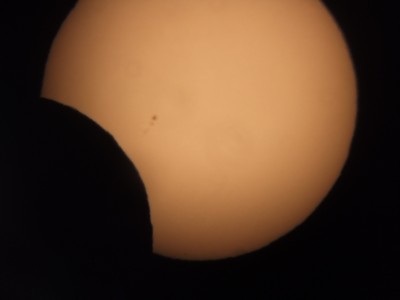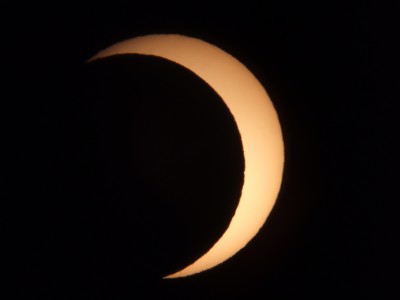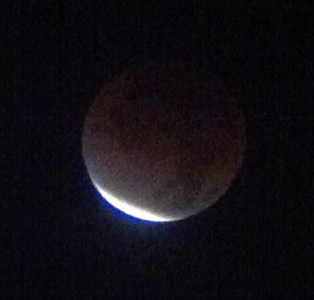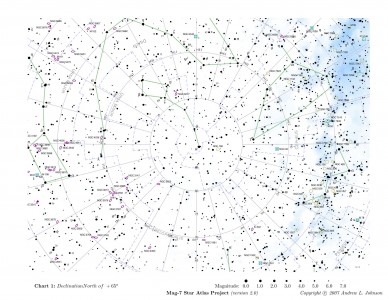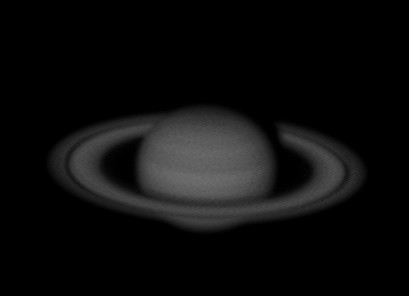Okay, these are the best of the photos that I snapped during yesterdays annular solar eclipse (well, it was really only a partial eclipse here). We had just left the Maker Faire, and were in the parking lot of Oracle on 10 Twin Dolphin Drive in Redwood City, CA. I took out my 4″ Meade Maksutov telescope, along with a full aperature solar filter and a 25mm eyepiece. To take the pictures, I used a Fuji W1 camera, held up to the eyepiece, set in manual mode with an exposure of 1/100th of a second and f/4. Alignment was tricky and twitchy, and there are more crappy photos than good ones. These aren’t particularly good, or sharp, but heck, they are mine, and as a reminder of a kind of neat event, they work just fine.
Category Archives: Astronomy
The Lunar Eclipse…
Okay, I did wake up for the lunar eclipse this morning. At 5:30 my alarm went off. I pulled on some clothes, wandered out to the front yard, and sure enough, the moon was already being devoured by the Earth’s shadow. I went back inside, and got my old pair of tripod-mounted aircraft spotting binoculars, and set them up across the street. Carmen joined me, and we got a nice view as the shadow covered the moon. I had Carmen’s Canon G11 but I don’t use it often enough, and was frankly too sleepy to figure it out, but I did manage to snap a few shots of it using my iPhone through the binoculars. Here is one of the best.
By the time 6:30 rolled around, the skies were brightening and the moon was sinking into the offshore clouds. We headed to Starbucks, and got a coffee, but that was it.
The eclipse was very dark though: darker than I remember seeing. And deep red. And my bifocals aren’t the greatest thing for staring at distant objects. But the binoculars worked out great.
Upcoming Total Lunar Eclipse
Yep, there is an upcoming total lunar eclipse this Saturday, on the morning of Dec 10. It will be the last total lunar eclipse visible from San Francisco until April of 2014, so I think I’ll be trying to get up and see if I can view it and take some snapshots. From San Francisco, will enter the penumbra at 3:34 local time. You should start seeing it enter partial eclipse around 4:46, and it will begin totality around 6:06 (at only 12 degrees of altitude). Totality ends around 6:57, with the moon at about 3 degrees altitude.
I’ll probably get out my aircraft spotting binocs, and try some ghetto “through the eyepiece” photography. Stay tuned.
Mag 7 Star Atlas Project
Tom mentioned that a new supernova had been found in M101, a spiral galaxy in Ursa Major. While I used to be a bit of a telescope maker, and could generally find my way around the sky, I wasn’t one hundred percent certain I knew where to find M101. So, I turned to my copy of
Uranometria 2000. And… I still didn’t know really. The charts in that book are good for star hopping at the eye piece of a telescope, but less so for just finding your way around the sky.
In digging around for a decent online map, I found a link to the Mag 7 Star Atlas Project by Andrew L. Johnson. It’s a very nice 21 page atlas, which is very pretty, and is excellent for both visual use, and use with small telescopes or binoculars. And it’s licensed under the Creative Commons too! Win!
Below is a JPEG of the first chart, rendered at 2K wide. The actual atlas is in PDF format, so will print out at the full device resolution, and will look even nicer.
Here’s the link:
Mag 7 Star Atlas Project : Andrew L. Johnson : Free Download & Streaming : Internet Archive.
Michael Bay and Basic Astronomy
I’ve seen lots of bashing of Michael Bay and his movies this weekend. Amongst the blogging world, there seems to be almost universal contempt the flashy, soul-less combination of flashy cars and collagen injected supermodels. And yet his latest release Transformers: Dark of the Moon just claimed the all time Independence Day record, amassing 156 million dollars in its first five day weekend, including (yes) $25 or so for me and my wife.
I’m not going to argue that Michael Bay deserves more respect (while his movies are popular, they do pander to teen-boy sensibilities) or less respect (that being said, his movies are enormously popular, and do have a visual style which I can appreciate). Instead, I’m merely going to nit-pick a single annoying set of mistakes that he perpetuates in Transformers: Dark of the Moon.
There is no “dark side of the moon”, any more than there is a dark side of the Earth.
(I might reveal minor plot points in the following discussion. You’ve been warned.)
Part of the premise of TDOTM is that the Apollo 11 landing was merely done to retrieve a crashed Autobot ship. Repeated reference is made to landing on the “dark side” of the moon, or loosing radio contact because Apollo 11 is now on the “dark side”.
Argh.
I’m going to blame Pink Floyd for this, although perhaps our own penchant for viewing things like the moon without really attempting to understand what we see is at least as likely to blame.
The moon revolves around the earth in about 27.3 days (a sidereal month). The moon’s rotation is synchronized to its orbital period, so that it presents the same side toward the earth (mostly, more below). Hence, we see the same side of the moon from our vantage point on earth all the time. Hence, it makes sense to speak of the “lunar near side” (the side we can see) and the “lunar far side”, the side we cannot. The first pictures of the lunar far side were taken by the Soviet Luna 3 probe back in 1959: prior to that, we knew essentially nothing about this far side.
But note: the far side isn’t “dark”, anymore than the near side is.
If you watch the face of the moon throughout a sidereal month, you can see the phases change. During a full moon, the visible, near side of the moon is fully illuminated, and the invisible, far side is fully dark. But one half a sidereal month later, we have a so-called “new moon”. Here, the near side is in shadow, and the far side is fully illuminated. And halfway between these two times, the near and far sides are both half lit and half in shadow.
During the Apollo missions, the Command Module would periodically go into “radio darkness” as it was hidden behind the moon, but this was merely because the moon would block radio signals aimed at the craft in lunar orbit. But this had nothing to do with whether the Command Module was in sunlight or not.
Of course, someone more illustrious than me has been through all this before.
It’s a minor nit to pick. And Michael Bay has done much, much worse. But this kind of basic illiteracy annoys me just as much as the obvious car and electronic product placements we see scattered throughout the film.
And yes, I can accept talking robots from outer space, the existence of something called Energon, and that hot chicks would like Shia Labeouf, but choose instead to pick this one nit. Sue me.
Addendum: We don’t see precisely the same side all the time. The moon’s orbit is elliptical, which means that it varies in distance between us. Because its angular velocity changes, but it’s rotational velocity does not, the moon is only on average in synchronous rotation. We can see about 9% more of the moon’s surface than we would if it was perfectly synchronous.
Addendum2: If you really want to nit pick, consider the effect of the Roche Limit and what it means when Cybertron is brought into earth orbit.
Addendum3: Also, for being the “Einstein of the Autobots”, Sentinel Prime was really, really stupid.
Addendum4: Yes, I get all the jokes on Big Bang Theory.
The Gyrator VLF receiver…
Back on June 7, there was a spectacular coronal mass ejection on the sun:
Yes, I did mention this event and gave some links to VLF receivers at the time, but I’ve been thinking about this some more.
As an astronomy/telescope buff, I have built simple telescopes for looking at the sun, but I haven’t done much of that lately, and I have only recently become interested in observing the sun’s effect on the Earth’s radio environment. I’ve also had a fairly longstanding interest in VLF communications, and so the prospect of building a radio system for monitoring radio for SIDs (Sudden Ionospheric Disturbances) seems like a good project. I recall that Mark Spencer, WA8SME whom I’ve had the pleasure of meeting at Pacificon and even chatted with via the AO-51 satellite had published some articles on designing such radios for amateur and educational construction.
The most common way to monitor for SIDs is to try to detect the signal strength of the VLF station in Cutler, ME on 24Khz. Changes in signal strength can indicate the presence of solar flare activity as the ionosphere is bombarded by high energy particles. One common circuit that lots of people use is called The Gyrator VLF circuit, which you can find here:
The Original Gyrator Circuit (PDF)
I had never really looked at this circuit very carefully before, and looking at it tonight, I realized that it was actually fairly interesting and employs a technique which I hadn’t seen before. Instead of making a tuned front end using a (fairly large, because of the low frequency) inductor, they create an equivalent circuit using two op amps and a collection of resistors. This creates an inductor with very high Q, with the side effect that is easier to make, using operational amplifiers that you can still get at Radio Shack. I’ll probably try to simulate some of the basics with LTSpice to gain some intuition as to what’s going on, but it’s a simple enough circuit that just building it would be pretty easy.
The basic circuit has undergone a couple of iterations, and now the Gyrator III schematic is recommended by the AAVSO. You can check out the details here (and surf around, the AAVSO has lots of information on this stuff).
Boom! A big solar flare, with some links…
This morning’s massive coronal mass ejection from the Sun got me scrambling around trying to remember details of how amateurs can monitor solar flare activity during the current solar cycle. Mark Spencer, WA8SME, had some articles on building a small monitoring station that detected SIDs, or “sudden ionospheric disturbances”. The basic idea is to create a VLF receiver to pick up signals such as the strong one megawatt transmitter on 24Khz in Cutler, Maine, and then graph the overall signal strength and record it on the computer equivalent of a strip recorder. I know I have the QEX article from 2008 where he described this system, but I can’t find it. You might find this article to be of interest, as well as the great efforts of the AAVSO (American Association of Variable Star Observers). Here is another receiver circuit that I ran across.. All good stuff.
Astronomical Musings: What day is Pixar-Henge day?
I’ve had a couple of conversations with Tom over the last couple of days, and they were curiously related. He just got back from a trip to Ireland where he visited Newgrange, a prehistoric tomb mound in County Meath. It actually predates the Great Pyramid at Giza, and predates Stonehenge by a thousand years.
One of its interesting feature is that on the date of the winter solstice, the rising sun illuminates the entire length of the main passage, providing 17 minutes of light to the inner chamber. Pretty neat. A lottery is apparently held each year for tickets to view this event (thousands apply, a couple of dozen are allowed to view).
Anyway, in a separate conversation, Tom announced that today, a similar event happened at Pixar. Our main building has a long corridor that runs east to west, and apparently this morning (May 6) was the date in which the rising (and setting) sun appears at the eastern (western) end of the corridor, and illuminates the entire hall.
So, Tom asked: “What’s the equivalent date when we can view this event again?”
A few minutes of thought told me that however many days we are away from the summer solstice, I could solve that if I could do add and subtract dates in my head, or by counting dates on a calendar, but I decided to use the pyephem library instead. I didn’t even write a program:
> python
Python 2.6 (r26:66714, Mar 17 2009, 11:44:14)
[GCC 4.4.0 20090313 (Red Hat 4.4.0-0.26)] on linux2
Type "help", "copyright", "credits" or "license" for more information.
>>> import ephem
>>> t = ephem.Date('2011/05/06')
>>> s = ephem.Date('2011/06/21')
>>> print ephem.Date(s+(s-t)*ephem.hour*24)
2011/08/06 00:00:00
In other words: the alternative “Pixar-Henge” day is August 6.
But what angle is our hallway aligned? For that., I fired up Google Earth, and used their measurement tools. Assuming that the long hallway runs parallel to the long side of the building, I determined that the length of our building was approximately 140 meters, and was at an angle of 75.22 degrees.
But here is the thing: I then did the calculation on pyephem to see what direction it thought the rising sun would be: and it came up with 68 degrees. That just seems wrong. Not sure what to think here. I’ll ponder it some more.
Jupiter, the Bringer of Jollity
Phil Plait dug out these amazing pictures taken by Damian Peach. If you go to your local library and look at astronomy books that were published when I was a kid, you’ll see no pictures like any of this. The combination of both computer algorithms and video hardware has put the ability to take astonishingly good imagery into the hands of amateur astrophotographers. Still, some efforts seem an order of magnitude more amazing than others, and these definitely count.
Jupiter, the Bringer of Jollity | Bad Astronomy | Discover Magazine.
httpv://www.youtube.com/watch?v=37upKkjSGvE
Astonishing.
Total Lunar Eclipse
On Monday, December 20th, we’ll have an opportunity to view a total lunar eclipse. Huzzah! It’s been quite a while since I’ve had the opportunity to view one. According to this NASA eclipse calculator, the moon should enter the penumbra of the earth at 9:29PM Pacific time, with the partial eclipse beginning at 10:33 and totality starting at 11:41PM. The middle of the eclipse occurs just after midnight at 12:17, and totality ends at 12:53 AM.
The weather outlook isn’t good, it is questionable as to weather we’ll be able to see it, but if it’s clear on Monday, try to check it out.
Using Registax…
Lots of amateur astronomers use Registax to do what is known as “Lucky Imaging”. The idea is that you record a bunch of video frames, and hope that you capture some moments of good seeing, which you then carefully align and average to remove noise, and then enhance. I was playing around with a sequence of 1200 frames that I found online, and in my first attempt of using this program, came up with this image of Saturn. Not bad. I keep thinking I should do some video astronomy, but never quite get around to it. Perhaps that should change.
Amateur Astronomers Detect Jupiter Impact
Two different amateur astronomers detected an object impacting Jupiter on June 3. Catch the video: it’s pretty impressive, and shows that amateurs can make interesting observations of our universe. If you haven’t looked through a telescope lately (or a good one) this video shows the role that atmospheric conditions play. As you watch carefully, fine details come and go in the span of just a few frames. One of the more interesting “revolutions” in amateur astronomy is to use video cameras to capture these moments of good seeing, and “stack” the resulting images into high quality composites. Anywho…. thought it was brilliant. Congratulations to Anthony Wesley and Christopher Go for these truly rare images.
Converting Microsoft Lifecam Cinema HD Webcam for Telescope Use
Before computers, my first love-affair with geekiness was an interest in telescopes and astronomy. For the past few years, I’ve slacked off considerably in my telescope making activities, but every once in a while I see something that piques my interest. Gary Honis has a fascinating webpage that details several conversions of digital SLR cameras and webcams into a form which allows them to be used for astrophotography. I found the following link to be particularly interesting for planetary photography, since the webcam is a reasonably high resolution and shoots at 30fps. For bright objects like the moon and planets, this means that you can capture moments of good seeing, and use them to generate nice pictures. Archived for future perusal:
Instructions for Converting Microsoft Lifecam Cinema HD Webcam for Telescope Use -by Gary Honis.
The camera is actually very reasonably priced (only $54.03 via Amazon).
Atlantis + ISS cross the Sun
Images of Objects in Orbit
Ralf Vandebergh has a really interesting web page, where he shows pictures of the ISS and Shuttle missions taken with a 10″ Newtonian telescope. The detail is really amazing.
Images of ISS, Space Shuttle and other spaceflight objects by Ralf Vandebergh
George Tarsoudis has similar equipment, and produces similarly impressive results:
